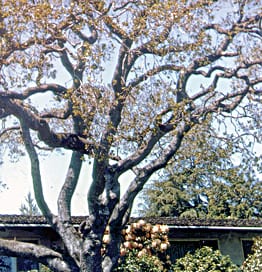Fusarium oxysporum (imperfect fungus)
Most plants are susceptible to some degree. Most commonly found on alder, bay tree, catalpa, elm, laurel, madrone, magnolia, mimosa, maple, oak, and olive.
This fungus is present in most agricultural, nursery, and landscaped soils.
Root wounding such as construction damage, transplanting, leaking gas lines, soil compaction. Also, nematodes, soil insects, drought, flooding, sudden heating of soil after cool season, low soil pH, excessive ammonia nitrogen, boron deficiency, low calcium and potassium deficiency are all contributing factors.
The symptoms include wilting or yellowing of some leaves, first on scattered top branches, often causing leaves to hang down. Leaves eventually die and drop. Death to tree usually within 18 months, depending on environmental conditions. Trunk and branches have a red to brown ring of discolored sapwood. Xylem often plugged with brown gum. Small branches may have one-sided wilting with the bark flattened over the collapsing tissue and a slight tendency to turn inward (“shepherd’s crook”).
This fungus is completely soilborne, infection generally arising from hyphae or by germination of two main spore types: microconidia and macroconidia. With its specialized, thick-walled resting spores (chlamydospores), it can survive long periods of unfavorable environmental conditions. In the presence of the proper host, these cells germinate when more moisture and higher temperatures are available.


